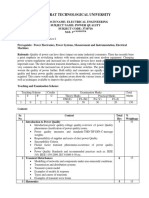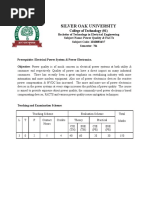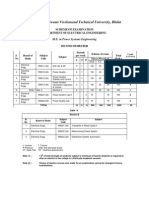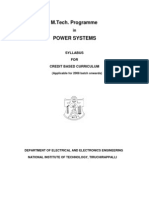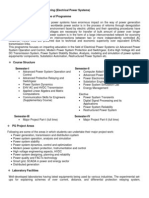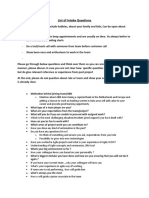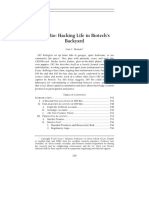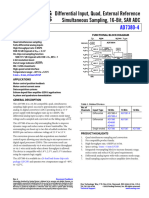Subject Code-Subject Name - Power Quality Improvement Programme: B.Tech - EE
Subject Code-Subject Name - Power Quality Improvement Programme: B.Tech - EE
Uploaded by
DharmdasCopyright:
Available Formats
Subject Code-Subject Name - Power Quality Improvement Programme: B.Tech - EE
Subject Code-Subject Name - Power Quality Improvement Programme: B.Tech - EE
Uploaded by
DharmdasOriginal Description:
Original Title
Copyright
Available Formats
Share this document
Did you find this document useful?
Is this content inappropriate?
Copyright:
Available Formats
Subject Code-Subject Name - Power Quality Improvement Programme: B.Tech - EE
Subject Code-Subject Name - Power Quality Improvement Programme: B.Tech - EE
Uploaded by
DharmdasCopyright:
Available Formats
GURU NANAK DEV ENGINEERING COLLEGE, LUDHIANA
Subject code-PEEE-121
Subject Name- POWER QUALITY IMPROVEMENT
Programme: B.Tech- EE L: 3 T: 1 P: 0
Semester: 8 Teaching Hours: 36L+12T=48 Hours
Theory/Practical: Theory Credits: 4
Internal marks: 40 Percentage of Numerical/Design/ Programming Prob-
lems:10%
External Marks: 60 Duration of End Semester exam (ESE): 3 hr
Total marks: 100 Elective Status: Department Elective
Prerequisites:
Additional Material allowed in ESE: Scientific Calculator
On Completion of the course, the student will have the ability to:
CO# Course Outcomes
1 Comprehend different types of power quality phenomena
2 Acquire knowledge of power quality standards and indices
3 Identify sources for voltage sag, voltage swell, interruptions, transients, long duration
over voltages and harmonics in a power system
4 Demonstrate the principle of voltage regulation and power factor improvement meth-
ods
5 Appreciate the relationship between distributed generation and power quality
6 Demonstrate the power quality monitoring concepts and the usage of measuring instru-
ments
PART-A
Introduction (12L+04T=16 Hours)
Overview of power quality – Concern about the power quality – General classes of power quality and
voltage quality problems – Transients – Long– duration voltage variations – Short–duration voltage
variations – Voltage unbalance – Waveform distortion – Voltage fluctuation – Power frequency
variations. Sources and Effects of power quality problems, types of power quality disturbances -
Voltage sag (or dip), Swell, Transients and voltage flicker. Nonlinear loads – IEEE and IEC standards.
CBEMA and ITIC Curves, Power Quality indices, Measurement of Power and Power Factor in non-
sinusoidal systems, Source of transient over voltages – Principles of over voltage protection – Devices
for over voltage protection – Utility capacitor switching transients.
Voltage Regulation and power factor improvement (06L+02T=08 Hours)
Principles of regulating the voltage – Device for voltage regulation – Utility voltage regulator
application – Capacitor for voltage regulation – End–user capacitor application – Regulating utility
voltage with distributed resources – Flicker – Power factor penalty – Static VAR compensations for
power factor improvement.
PART-B
Harmonic distortion and solutions (06L+02T=08 Hours)
Voltage distortion vs. Current distortion – Harmonics vs. Transients – Harmonic indices – Sources of
Page 105 of 143
GURU NANAK DEV ENGINEERING COLLEGE, LUDHIANA
harmonics – Effect of harmonic distortion – Impact of capacitors, transformers, motors and meters –
Point of common coupling – Passive and active filtering – Numerical problems.
Distributed Generation and Power Quality (06L + 02T = 08 Hours)
Resurgence of distributed generation – DG technologies – Interface to the utility system – Power
quality issues and operating conflicts – DG on low voltage distribution networks.
Monitoring and Instrumentation (06L+02T=08 Hours)
Power quality monitoring and considerations – Historical perspective of PQ measuring instruments –
PQ measurement equipment – Assessment of PQ measuring data – Application of intelligent systems
– PQ monitoring standards.
Textbooks
1. R C Dugan, M F McGranaghan, S Santoso, and H W Beaty, Electrical Power Systems Quality,
Second Edition, McGraw–Hill, 2012.
2. M.H.J. Bollen Electric power quality problems IEEE series-Wiley india publications, 2011.
3. B W Kennedy Power Quality Primer, , First Edition, McGraw–Hill, 2000.
Reference Books
1. M HJ Bollen Understanding Power Quality Problems: Voltage Sags and Interruptions, , First
Edition, IEEE Press; 2000.
2. J Arrillaga and N R Watson Power System Harmonics, , Second Edition, John Wiley & Sons,
2003.
3. W. E. Kazibwe and M. H. Sendaula, Van Nostrad Reinhold, New York. Electric Power Quality
control Techniques, 2000
4. C. shankaran Power Quality, CRC Press, 2001
5. C.DE Franciso LA Rosa–CRC Press (Taylor & Francis).Harmonics and Power Systems, 1980
6. E.F. fuchs, Mohammad A.S. Masoum–Elsevier.Power Quality in Power systems and Electrical
Machines , 2000
Page 106 of 143
You might also like
- Microsoft Test-Inside sc-200 Dumps 2022-Oct-15 by Berg 94q VceDocument9 pagesMicrosoft Test-Inside sc-200 Dumps 2022-Oct-15 by Berg 94q VceSrinivas Naidu T SNo ratings yet
- M Tech Power System SyllabusDocument28 pagesM Tech Power System Syllabusvaibhav_yadav798No ratings yet
- Lesson Plan Academic Year: 2016-17 2016/Univ/Eee/LpDocument12 pagesLesson Plan Academic Year: 2016-17 2016/Univ/Eee/LpharimadhavareddyNo ratings yet
- Power Quality Course OutlineDocument3 pagesPower Quality Course OutlinechalaNo ratings yet
- Gujarat Technological UniversityDocument3 pagesGujarat Technological UniversityTanvi IsraniNo ratings yet
- 11power Quality EngineeringDocument1 page11power Quality Engineeringpurushotham1982No ratings yet
- Lesson Plan Academic Year: 2018-19 2018/Univ/Eee/LpDocument22 pagesLesson Plan Academic Year: 2018-19 2018/Univ/Eee/LpharimadhavareddyNo ratings yet
- Syllabus - IInd Sem Power ElectronicsDocument9 pagesSyllabus - IInd Sem Power ElectronicsUmashankar VermaNo ratings yet
- Power Quality Lesson PlanDocument2 pagesPower Quality Lesson PlanAnonymous HyOfbJ6No ratings yet
- EE593Document4 pagesEE593hassanNo ratings yet
- MuxibozedikDocument11 pagesMuxibozedikamrutha cNo ratings yet
- 10ec73 Power Electronics Vtu SyllabusDocument2 pages10ec73 Power Electronics Vtu SyllabusYaichenbaPebam100% (1)
- 3.1 Control Systems: RationaleDocument15 pages3.1 Control Systems: RationaleSoumya BhattacharyaNo ratings yet
- Power Quality FACTsDocument5 pagesPower Quality FACTsshashiNo ratings yet
- Eee 8th Sem r2008Document18 pagesEee 8th Sem r2008Ashok VannanNo ratings yet
- ELECTENG 731 Lecture 1 2015 NirmalDocument39 pagesELECTENG 731 Lecture 1 2015 NirmalJohn SmithNo ratings yet
- Electrical Power Quality: Course Code: 15EE1140 L T P C 3 0 0 3Document3 pagesElectrical Power Quality: Course Code: 15EE1140 L T P C 3 0 0 3Shiv RxNo ratings yet
- Electrical Engineering: Syllabus of Undergraduate Degree CourseDocument27 pagesElectrical Engineering: Syllabus of Undergraduate Degree CourseKrishnawtar SoniNo ratings yet
- Electrical Engineering 05Document32 pagesElectrical Engineering 05riturajsrathoreNo ratings yet
- Power Quality and FactsDocument3 pagesPower Quality and FactsEle052 Patel MilanNo ratings yet
- EE801 Course PlanDocument2 pagesEE801 Course PlanBala SubramanianNo ratings yet
- Syllabus of Ph. D. (Engg.) Admission Test (From Electrical Engineering Department)Document5 pagesSyllabus of Ph. D. (Engg.) Admission Test (From Electrical Engineering Department)PradyumnaRoyNo ratings yet
- Power Quality Engineering: Euci Presents Course OnDocument5 pagesPower Quality Engineering: Euci Presents Course OnSandeep ArNo ratings yet
- BewakoofDocument10 pagesBewakoofAkhil AroraNo ratings yet
- PQ SyllabusDocument2 pagesPQ Syllabussundeep sNo ratings yet
- Topic: Power Quality Enhancement Using Power Electronics DevicesDocument5 pagesTopic: Power Quality Enhancement Using Power Electronics DevicesParth Salat0% (1)
- lect1_pqDocument17 pageslect1_pqsusilmajhi25No ratings yet
- 2 Sem ME Elect PowerDocument10 pages2 Sem ME Elect PowerAkash YadavNo ratings yet
- Lect 1Document17 pagesLect 1ssushreeta46No ratings yet
- Peca Course Policy PDFDocument9 pagesPeca Course Policy PDFAayush NandolaNo ratings yet
- PE SyllabusDocument2 pagesPE SyllabusRahul KulkarniNo ratings yet
- BEE 4101 Power Electronics Course OutlineDocument3 pagesBEE 4101 Power Electronics Course Outlinelemi.terekaNo ratings yet
- Power Quality Analysis Using Fuzzy Logic Ijariie13427Document15 pagesPower Quality Analysis Using Fuzzy Logic Ijariie13427ntsuandihNo ratings yet
- M Tech EEE Ist Sem - SyllabusDocument10 pagesM Tech EEE Ist Sem - SyllabusAbhishek GahirwarNo ratings yet
- Chhattisgarh Swami Vivekanand Technical University, Bhilai: Total Period 08Document19 pagesChhattisgarh Swami Vivekanand Technical University, Bhilai: Total Period 08Piyush KumarNo ratings yet
- CBGS 6 SEM090323052730Document11 pagesCBGS 6 SEM090323052730patelhemant260105No ratings yet
- Mod 1 Introduction To PQDocument78 pagesMod 1 Introduction To PQseemapdiNo ratings yet
- Unit 1Document21 pagesUnit 1Rajesh BembadiNo ratings yet
- Epq SyallDocument1 pageEpq Syallanushka meenaNo ratings yet
- 29 ML839 Power ElectronicsDocument2 pages29 ML839 Power Electronicsjimmy jimenez barriosNo ratings yet
- Curriculum For MTech in Power Systems ProgrammeDocument20 pagesCurriculum For MTech in Power Systems ProgrammeheerapotterNo ratings yet
- EE2004 1 Nature of Electrical Energy System UpdateDocument65 pagesEE2004 1 Nature of Electrical Energy System Updateanimation.yeungsinwaiNo ratings yet
- M Tech EEE IInd Sem - SyllabusDocument10 pagesM Tech EEE IInd Sem - SyllabusAbhishek GahirwarNo ratings yet
- 18EE56 - SyllabusDocument2 pages18EE56 - Syllabusrsvuu16No ratings yet
- 18 - A Study PDFDocument6 pages18 - A Study PDFAman MalikNo ratings yet
- Syllabus For B. Tech in Electrical EngineeringDocument20 pagesSyllabus For B. Tech in Electrical EngineeringRISHAV kumarNo ratings yet
- Nptel: Power Electronic Applications in Power Systems - Web CourseDocument2 pagesNptel: Power Electronic Applications in Power Systems - Web CourseTiya gonekarNo ratings yet
- Electromedicion MonitoreoDocument13 pagesElectromedicion MonitoreoFernanda CamperoNo ratings yet
- Mod 1 PG Introduction To PQDocument91 pagesMod 1 PG Introduction To PQSeema P DiwanNo ratings yet
- PQ Sesi 1 SalembaDocument12 pagesPQ Sesi 1 SalembaAprian Dwi RahmanuNo ratings yet
- Indian - Syllabus For Power QualityDocument2 pagesIndian - Syllabus For Power Qualitybhuvana71No ratings yet
- Hitecuniversity: Department of Electrical EngineeringDocument3 pagesHitecuniversity: Department of Electrical EngineeringAbdullah NasirNo ratings yet
- Subject code-PEEE-117 Subject Name-High Voltage Engineering Programme: B.Tech - EEDocument2 pagesSubject code-PEEE-117 Subject Name-High Voltage Engineering Programme: B.Tech - EEDharmdasNo ratings yet
- Electrical New SyallabusDocument65 pagesElectrical New SyallabusSuraj KanojiaNo ratings yet
- Ee PSDocument2 pagesEe PSDeepu ChinnaNo ratings yet
- Power Quality TechniquesDocument9 pagesPower Quality TechniquesS Bharadwaj ReddyNo ratings yet
- Ee001 Power Generation Systems: L T P CDocument32 pagesEe001 Power Generation Systems: L T P CPARTH DAVENo ratings yet
- Introduction Power Systems 08 ADocument161 pagesIntroduction Power Systems 08 Abaosyle9201No ratings yet
- Kolhapur Institute of Technology's College of Engineering, (Autonomous), KolhapurDocument1 pageKolhapur Institute of Technology's College of Engineering, (Autonomous), KolhapurRakesh DesaiNo ratings yet
- ENA Lab Report Transient AnalysisDocument8 pagesENA Lab Report Transient Analysispvi31092No ratings yet
- T4S/Catena: Agil Modular Ups VersionDocument2 pagesT4S/Catena: Agil Modular Ups Versionluis fernando garciaNo ratings yet
- Projectile - The Case Study Competition - Case ProblemDocument5 pagesProjectile - The Case Study Competition - Case ProblemB D CNo ratings yet
- BCWP 1Document18 pagesBCWP 1d_tantubaiNo ratings yet
- SR - Case#21348 UnilabDocument2 pagesSR - Case#21348 UnilabDhexter VillaNo ratings yet
- AHK3000 Series Programming Application V2 20-10-08Document16 pagesAHK3000 Series Programming Application V2 20-10-08l00pback63No ratings yet
- Round Bottom Flask Temperature P Q R S TDocument2 pagesRound Bottom Flask Temperature P Q R S Tcyberbat2008No ratings yet
- Figure 5 - Orion Modbus IED Port Configuration ScreenDocument1 pageFigure 5 - Orion Modbus IED Port Configuration Screenmalik.ai.tech100No ratings yet
- Product Categories - Trade Fair METECDocument3 pagesProduct Categories - Trade Fair METECkarin leyvaNo ratings yet
- Constraints and Triggers: Deferring Constraint CheckingDocument82 pagesConstraints and Triggers: Deferring Constraint Checkingsubash pradhanNo ratings yet
- Don Bosco Tvet Center-Calauan, Inc.: (Morning/Afternoon Session)Document4 pagesDon Bosco Tvet Center-Calauan, Inc.: (Morning/Afternoon Session)Juliet N. CoronadoNo ratings yet
- Python Pandas MatplotDocument15 pagesPython Pandas MatplotRafay FarooqNo ratings yet
- Questions - Topics Data Eng - FresherDocument6 pagesQuestions - Topics Data Eng - Fresherabhinav khokharNo ratings yet
- ASTM E1557-02 UniformatIIDocument24 pagesASTM E1557-02 UniformatIIRaymond Carlson100% (2)
- Biohacking PrinciplesDocument30 pagesBiohacking PrinciplesaldrynNo ratings yet
- 6-Pin Wire Harness Assembly Installation GuideDocument2 pages6-Pin Wire Harness Assembly Installation Guidelucian stoianofNo ratings yet
- ICT 1 - Course OutlineDocument4 pagesICT 1 - Course OutlineKristine Joy MartinezNo ratings yet
- What Are Storage Device: ICT Long #1Document8 pagesWhat Are Storage Device: ICT Long #1Ȼħ ŠultanNo ratings yet
- CSS Chapter 2.1Document28 pagesCSS Chapter 2.1Raymond PunoNo ratings yet
- AD7380Document31 pagesAD7380Muhammad Qasim RaufNo ratings yet
- Templates - Feeder SegregationDocument10 pagesTemplates - Feeder SegregationSandeep ChoudharyNo ratings yet
- Mod BL CRP/L/CR: Made in Italy With Italian Fashion MindDocument2 pagesMod BL CRP/L/CR: Made in Italy With Italian Fashion MindSenthil KumarNo ratings yet
- CDCAP 01 Business Need - v1.2Document37 pagesCDCAP 01 Business Need - v1.2down42roadsNo ratings yet
- Vivo MobileDocument3 pagesVivo Mobilekalaivani60% (10)
- Group 2 - MCOLORT Brand BookDocument25 pagesGroup 2 - MCOLORT Brand BookIshi EvansNo ratings yet
- List of Architectural Thesis Topics PDFDocument8 pagesList of Architectural Thesis Topics PDFfc34qtwg100% (2)
- Cable TesterDocument2 pagesCable TesterVirga 'Ryan' LibrianNo ratings yet
- Interiors Vocabulary NotesDocument2 pagesInteriors Vocabulary NotesMaria BaezNo ratings yet




